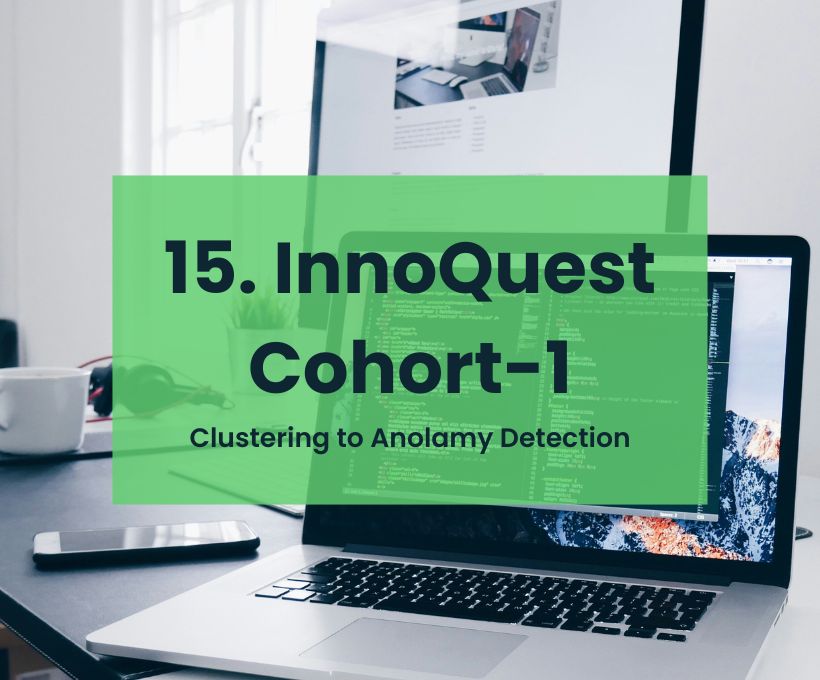Table of Contents
- Introduction
- K-Means Clustering
- Hierarchical Clustering
- Anomaly Detection
- Principle Component Analysis (PCA)
- Recommendation Systems
- Future Plans
- Conclusion
- Let’s Connect
Introduction
Artificial Intelligence (AI) and Machine Learning (ML) have transformed the way industries operate. The opportunity to delve into these transformative technologies in the Innoquest Cohort-1 Professional AI/ML Training Program has been an enlightening journey. In Class 15, we explored advanced topics such as clustering, anomaly detection, principal Component Analysis (PCA), and Recommendation systems (some of the highly used techniques to boost businesses’s performance), which not only deepened our understanding of machine learning but also equipped us with skills to tackle real-world challenges. Here’s an overview of what we covered and how it inspired me to develop amazing AI applications.
Understanding K-Means Clustering
K-means clustering is a powerful unsupervised learning technique that segments data into clusters. Here’s what we learned:
- Intuition and Workflow: K-means assigns data points to clusters based on proximity to centroids, iteratively updating these centroids until optimal clusters are formed.
- Downsides: Despite its efficiency, K-means can be sensitive to the number of clusters (k), initialization, and outliers, often requiring pre-processing for robust results.
Hierarchical Clustering
Unlike K-means, hierarchical clustering creates a tree-like structure to group data.
- Approaches:
- Agglomerative: A bottom-up method where individual data points merge into clusters.
- Divisive: A top-down approach starting with one cluster and splitting iteratively.
- Link Methods:
- Single-Link Method: Focuses on the closest pair of points for merging individual clusters, but may produce a biased, chain-like structure.
- Complete-Link Method: Balances cluster tightness, avoiding excessive chaining but potentially underestimating cluster spread.
Anomaly Detection
Detecting anomalies is crucial for identifying unusual patterns in data. We explored several techniques:
1. Using Box Plot
A visual method where anomalies are identified as points beyond the whiskers of the plot.
2. Using Probability Distribution Function (PDF)
A mathematical approach analyzing the probability of observations:
- Area Under the Curve (AUC): Helps calculate the probability density of a data point lying within a range.
- Anomalies fall outside the bounds where AUC is negligible.
3. Scatter Plot Analysis
A quick way to visualize outliers based on their deviation from data trends.
4. Defining Lower and Upper Bounds
Statistical thresholds, such as interquartile ranges (IQR) or standard deviation, are used to define data bounds and detect anomalies effectively.
Principal Component Analysis (PCA)
Dimensionality reduction is key for handling large datasets. PCA enables this by transforming features into uncorrelated principal components.
- Eigenvectors and Eigenvalues:
Eigenvectors define directions, while eigenvalues represent the magnitude of variance captured by these directions. - Dimensionality Reduction:
PCA helps select components with the highest variance, simplifying datasets while retaining essential patterns.
Recommendation Systems
Recommendation systems are the backbone of personalization in AI. We covered two major approaches:
- Content-Based Filtering: Recommends items similar to what users previously engaged with. My project, Movies Recommendation System demonstrates this technique by analyzing descriptions, movie genres, actors, and other meta data.
- Collaborative Filtering: Leverages user behavior and preferences to recommend items, even if the user hasn’t interacted with them before.
Real-World Application and Future Plans
This class inspired me to develop more practical projects addressing real-world challenges:
- Customer Segmentation: Using clustering to identify customer groups for tailored marketing strategies.
Conclusion
Class 15 at Innoquest Cohort-1 marked a significant milestone in my AI/ML journey. By mastering clustering, anomaly detection, PCA, and recommendation systems, I’m equipped to tackle real-world problems and deliver impactful solutions. With each project, I’m not just learning—I’m building tools that can transform industries.
Let’s Connect!
If you’re curious about these techniques or have a project idea in mind, feel free to reach out. Together, we can create AI solutions that make a difference.

Assalamualaikum
My name is aina Muhammad Ali
and recently 2nd year completely in my college I my graduation degree with online Alison website